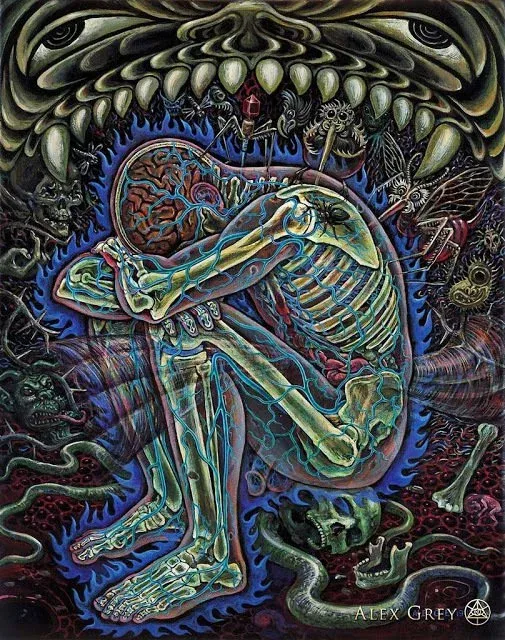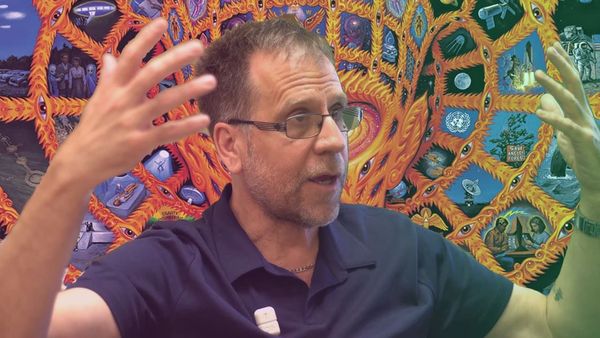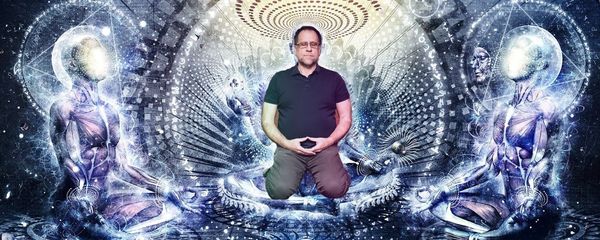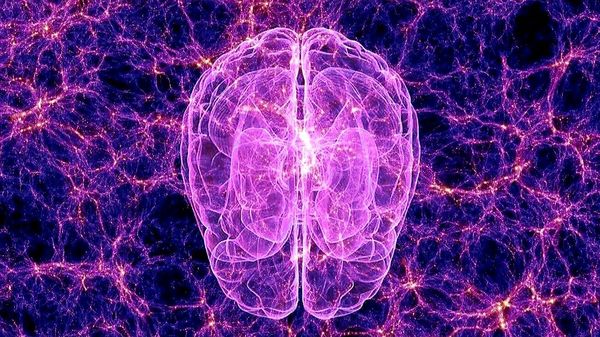Steve Taylor • • 11 min read
The Perennial Philosophy: Are Spiritual Traditions Different Expressions of the Same Truths?

When we look at the world’s spiritual traditions—such as Buddhism, Taoism, Hinduism, Sufism, and mystical Christianity and Judaism—it is tempting to believe that underlying each is a ‘common core’ of principles.
This is sometimes expressed in the concept of the ‘perennial philosophy,’ as popularized by the religious scholar Huston Smith and the author Aldous Huxley. Perennialism suggests that the world’s great ‘wisdom traditions’are different articulations of the same fundamental truths.
However, under the influence of post-modern cultural theories, many religious scholars turned away from the idea of perennialism, suggesting that it was naive and ignored significant differences between traditions. There was a shift toward ‘contextualism’ or ‘constructivism’, which saw traditions as independent and suggested that the spiritual experiences of individuals from different traditions were fundamentally different since they were created by the concepts and practices that are distinct to those traditions.
This shift from perennialism to contextualism also took place in my own field of transpersonal psychology. Until about 15 years ago, transpersonal psychology was closely affiliated with spiritual and religious traditions and heavily influenced by the writings of Ken Wilber, who advocated his own nuanced version of the perennial philosophy. But around the turn of the century, there was a movement toward a more pluralist perspective, beginning with Jorge Ferrer’s influential book Revisioning Transpersonal Theory. The book was highly critical of perennialism (and of Wilber). Ferrer didn’t deny that there was some common ground between different traditions, speaking of a “common spiritual dynamism underlying the plurality of religious insights and ultimates.”
However, he believed that the similarities between traditions had been overstated by perennialists. For example, across the world’s spiritual traditions, there are different concepts of some fundamental spiritual principles, which are seen as the essential reality of the world—the Tao, brahman, dharmakaya, the One, the Godhead, and so on. A perennialist would say these are simply different interpretations of the same spiritual force, which is accessible to all human beings in deep states of meditation, or in higher states of consciousness. However, Ferrer suggested that there are ‘a multiplicity of spiritual absolutes’ that shouldn’t be conflated. Other transpersonal psychologists, such as Glenn Hartelius, also turned away perennialism, suggesting not only that the similarities between traditions had been exaggerated, but that any similarities that did exist could be explained in terms of biological and neurological factors.
However, it seems to me that this is a case of ‘throwing the baby out with the bathwater.’ I think religious scholars and transpersonal psychologists were right to move away from the naive perennialism of earlier scholars, but that they have moved too far in the other direction. They have become too relativistic and unnecessarily skeptical toward the shared background of spiritual traditions.
Experiences Across Traditions
It’s important to make a distinction between philosophy and experience. It’s true that there are significant differences between the teachings of different spiritual traditions. But when we look at the experiences that are reported in different traditions (and outside them), the similarities are striking.
Here I’m speaking specifically about what are sometimes called ‘mystical experiences’ or ‘spiritual experiences.’ They might occur in states of deep meditation, when a person’s mind becomes quiet and they experience a sense of inner emptiness, without thoughts or concepts. Or it might be an experience of communion with nature, in which a person’s surroundings seem to become more real and beautiful, as if a new dimension of reality has been added to them.
All things may seem interconnected, as if they are expressions of something greater than themselves. The person might feel that they are part of this interconnectedness too, as if they have lost all sense of separateness.
Such experiences are common to adherents of different spiritual traditions, and also to people who don’t have any connection to spiritual traditions. A study by the religious scholar Kenneth Rose compared the meditative practices of Theravada Buddhism, Hindu Yoga, and Catholic mystical theology, and found that they describe “virtually identical sets of mystical experience that are induced by the deepening concentration.” Another scholar, Randall Studstill, found deep similarities between Tibetan Buddhist practices and experiences of medieval German mystics. Both involved “an increasingly sensitized awareness/knowledge of Reality that manifests as (among other things) an enhanced sense of emotional well-being, an expanded locus of concern engendering greater compassion for others” (1).
In 1975, the religious scholar Ralph Hood developed a “mysticism scale” to investigate mystical experiences. The items on the scale tested for characteristics such as a transcendence of the normal sense of self, a sense of the interconnectedness of things, a sense of an ‘inner subjectivity’ in phenomena, and a sense of joy or bliss. Studies using the scale have found that people in different spiritual traditions experience these core characteristics, even if they are interpreted in different ways. As one paper co-authored by Hood puts it, “the phenomenology of mystical experience reveals a common experiential core that can be discerned across religious and spiritual traditions”(2).
This is important because it suggests that experiences of people of different traditions are not independent and not just created by the beliefs and practices of those traditions. In other words, it invalidates the contextualist argument. There are obviously different interpretations and conceptualizations—due to different philosophical approaches and cultural practices—but there is a kernel of unity behind the experiences.
We could think in terms of expansive ranges of human consciousness, which exist as potentials within the human psyche, and are potentially accessible to all human beings—particularly through the practice of meditation, or emptying the mind of thought. Or more metaphorically, we could think in terms of a landscape of expansive human experience, which lies beyond the limits of ordinary, limited human awareness. This landscape can be viewed from different vantage points, and explored across different trajectories, so that different aspects of it may be more apparent to some people than others. And the philosophical and cultural background of different observers will lead them to focus on different aspects of the landscape, and emphasize different characteristics of it. But all the time, it’s the same fundamental landscape of experience that they are describing.
Experiences Outside Traditions
This becomes even clearer when we consider expansive states of being that take place outside the context of spiritual traditions. This has been another finding of studies using Hood’s M-Scale—that the experiences of ‘spiritual but not religious’ people (who were not attached to any particular tradition) also feature the core characteristics of transcendence of separation, sense of interconnection, and so on. This is a finding of my own research too. In my studies of what I call ‘awakening experiences’—essentially the same as mystical experiences—I have found that such experiences often occur outside the context of spiritual practices or paths. Most people have them in the midst of everyday activities like walking in the countryside, running or swimming, listening to or playing music, having sex or in the midst of psychological turmoil. Many people who have these experiences don’t know anything about spiritual practices or traditions.
Experiences that occur outside the context of religious or spiritual traditions—to people who had little or no knowledge of these traditions—can hardly be viewed as constructed by them. It is also significant that most of the participants of my research lived in secular Western cultures whose worldview does not support or encourage spiritual experiences. This makes it unlikely that the experiences were culturally constructed in a wider sense, through a desire to claim to have experiences that have high cultural value.
This also applies to the spiritual experiences of children. Studies have shown that temporary awakening experiences occur regularly during childhood. Researchers such as Edward Robinson and Edward Hoffman have found that spiritual experiences can occur as early as 3 years old, although they are most common between the ages of 5 and 15. It is difficult to see how such experiences could be constructed by religious or spiritual traditions, when a significant proportion of them occur at such a young age, before cultural conditioning could fully inform a child’s outlook. (Although of course there will undoubtedly be some cultural influence in the way that the experiences are described in later life.) Again, it suggests that we are dealing with a fundamental psychological landscape of expansive experience, which is accessible to all human beings, inside and outside spiritual traditions.*
Permanent Spiritual Awakening
So far I’ve been discussing temporary experiences, but it is important to note that awakening can occur on an ongoing basis too. That is, it is also possible for people to shift into a permanent expansive state of being, in which they experience some of the characteristics of awakening experiences (like intense perception, a transcendence of separateness, a sense of wellbeing and of the interconnectedness of things) in a stable way, as a part of their normal experience.
This type of ongoing awakening is often cultivated in the context of spiritual traditions, through following certain practices and lifestyle guidelines. A contextualist would argue that each tradition has its own concept of awakening, based on its own philosophical and cultural perspectives.
However, a few years ago, I studied the developmental systems of different traditions (including Hindu Vedanta, Taoism, Sufism, Theravada and Zen Buddhism, mystical Christianity and Judaism) and found that all conceived of a process of awakening (or moving towards an ideal, higher-functioning state) in a very similar way.
Specifically, I identified seven common themes in their depiction of this process:
- Increasing and intensifying awareness
- Moving beyond separateness, towards connection and union
- Cultivating inner stillness and emptiness
- Developing increased inner stability, self-sufficiency, and equanimity
- Moving towards increased empathy, compassion, and altruism
- The relinquishing of personal agency
- Moving towards enhanced well-being.
These themes are certainly conceptualized in different ways and are given different degrees of emphasis, but the similarities are very striking. (3)
It seems a stretch to argue that these similarities are due to the transmission of ideas from culture to culture. In the earlier centuries when these traditions developed, there was very little opportunity for such cultures to exchange ideas. And even if there was some kind of chain of influence, surely these depictions (together with accounts of spiritual experiences) would have altered beyond recognition over centuries of dissipation (as in the game of Telephone) rather than remaining similar.
As with temporary awakening experiences, it is significant that in my research I have found that this state of ongoing ‘wakefulness’ can sometimes arise outside the context of spiritual traditions. I have found that sometimes, in the midst of intense psychological turmoil, people may undergo a sudden and dramatic shift into an expansive, higher-functioning state that is strikingly similar to the expansive or awakened states described in spiritual traditions. This occasionally happens after a diagnosis of cancer or a bereavement, a near-death experience. or in the midst of intense depression or addiction. I describe many examples in my books Out of the Darkness and The Leap.
In a typical example, a person feels a new sense of appreciation, so that things they used to take for granted seem precious. They feel a new sense of connection to nature and other people, with increased compassion and altruism. The world seems more beautiful and real to them than it did before. They feel a new sense of purpose and meaning. In the above books, I refer to these people as ‘shifters,’since they felt that they had ‘shifted up’to a higher state of being.
In most cases, these transformational experiences didn’t happen in the context of spiritual traditions. In fact, most people didn’t have any knowledge of spiritual traditions or practices at the time. In many cases, this initially caused some confusion, since the individuals did not have an intellectual framework to make sense of their new ongoing state of being. Even afterward, once they had begun to recognize the basic elements of their experience within spiritual texts and teachings (and so begun to understand their new state), they didn’t usually become affiliated with any particular tradition.
Again, this strongly suggests that contextualism is wrong. If states of ‘wakefulness’ sometimes arise spontaneously outside spiritual traditions, it means that we are dealing with experiences that are fundamentally psychological, and which actually precede interpretation by spiritual traditions. The experiences are described in different ways by different traditions, but there is a more fundamental psychological landscape that underlies and informs the traditions. We might say that, throughout history, contemplatives have become aware that it is possible to explore this psychological landscape of expansive experience—most notably, through meditative practices. Some contemplatives developed frameworks of techniques and lifestyle guidelines, designed to make these realms accessible. These developed into different spiritual traditions, and there was a good deal of variation between them. But the same expansive psychological realms lie behind them, explored and conceptualized in different ways.
A New Day for Perennialism?
I believe that religious scholars and transpersonal psychologists alike have been too hasty in their rejection of perennialism. Perhaps scholars were too enthusiastically swept away by the tide of post-modernism relativism which overran academia towards the end of the last century. But now that tide seems to be receding, we can perhaps see more clearly where we are. And encouragingly. there are some signs that perennialism is returning. The religious scholar Kenneth Rose has even spoken of a “new day for perennialism” and the “recovery of mystical essentialism” (4).
Significantly though, I don’t believe that we should return to the ‘hard’ perennialism associated with figures like Huston Smith and Aldous Huxley. I believe we should adopt a more moderate position, a ‘softer’ kind of perennialism that is based on experiences rather than teachings. Strictly speaking, this would not be a perennial philosophy but a ‘perennial experience’ (or to put it more accurately, a perennial phenomenology). In a joint paper, Glenn Hartelius and Jorge Ferrer argued that “the more closely accounts from different mystical traditions are compared, the more they can be seen to differ” (5). But while this may apply to the teachings—or philosophy—of different mystical traditions, it does not apply to actual mystical experiences.
If we adopt a ‘soft perennialist’ model, we don’t need to think in terms of common spiritual absolutes, or to believe that all spiritual traditions are heading along the same path towards the same goal. In the ‘soft perennialist’ model, there is a lot of room for variation.
We can think in terms of ranges of expansive experience that have certain qualities and characteristics but don’t necessarily lead to any specific goal. We also don’t need to think in terms of a transcendent spiritual principle which exists apart from the world, but an immanent, all-pervading spiritual force, which is the essence of our being, and of everything else in the world. In this way, a ‘soft perennialism’ isn’t subject to the criticisms that Jorge Ferrer has made of perennialism. Certainly, some form of perennialism is needed, in order to account for the remarkable commonalities in awakening experiences that occur across and outside spiritual traditions, and in view of the problems I have highlighted with contextualism.
In my view, transpersonal psychology’s swing to relativism and skepticism will correct itself, and the field will find a new balance which incorporates a more nuanced and subtle form of perennialism. As in so many other cases, the most sensible position lies between two extremes.
________________________________
(note:)*The religious scholar Paul Marshall has identified three other problematic issues with contextualist interpretations of mystical experiences. Firstly, there is a disparity between experience and content (that is, mystical experiences often diverge from the contexts and concepts of the traditions they are associated with). Secondly, there is the problem of difficulty of expression. In other words, if mystical experiences are constructs of the traditions they are associated with, surely it should be easy to describe them with reference to the concepts to these traditions—but of course, the opposite is frequently the case. Finally, there is the failure of contextualists to distinguish between different levels of interpretation, or to take into account evidence showing that perception is largely independent of high-level cognitions such as theories and beliefs, so that as Marshall has put it, “the power of theories and beliefs to condition perception has firm limits.”(6).
References
1. Studstill, R. (2005). The unity of mystical traditions: The transformations of consciousness in Tibetan and German mysticism. Leiden, Netherlands: Brill, p.7.
2. Chen, Z., Qi, W., Hood, R. W., & Watson, P. J. (2011). Common core thesis and qualitative and quantitative analysis of mysticism in Chinese Buddhist monks and nuns. Journal for the Scientific Study of Religion, 50(4), 654-670, p.654.
3. Taylor, S. (2016a). From philosophy to phenomenology: The argument for a “soft”perennialism. International Journal of Transpersonal Studies, 35(2), 17-41 https://digitalcommons.ciis.edu/ijts-transpersonalstudies/vol35/iss2/4/
4. Rose, K. (2016). Yoga, meditation, and mysticism: Contemplative universals and meditative landmarks. London, UK: Bloomsbury, p.4.
5. Hartelius, G., & Ferrer, J. N. (2013). Transpersonal philosophy: the participatory turn. In Friedman & Hartelius (Eds.), The Wiley-Blackwell handbook of transpersonal psychology (pp. 187-202). Chichester, West Sussex, UK: John Wiley & Sons. https://doi. org/10.1002/9781118591277.ch10, p. 190.
6. Marshall, P. (2005). Mystical encounters with the natural world: Experiences and explanations. Oxford, UK: Oxford University Press. https://doi. org/10.1093/0199279438.001.0001










